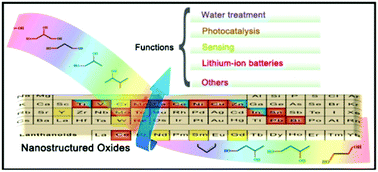From solid-state metal alkoxides to nanostructured oxides: a precursor-directed synthetic route to functional inorganic nanomaterials
Abstract
Functional nanostructured oxides are important inorganic materials for various energy- and environment-related applications, such as photocatalysis and lithium ion batteries. To optimize their properties/functions, synthetic methods that can lead to nanomaterials with unique composition, morphology and size are highly desirable. In this review, we summarize recent research efforts towards the construction of nanostructured solid-state metal alkoxides-a family of inorganic–organic hybrid compounds and their conversion into functional inorganic nanomaterials. The chemical transformation from metal alkoxides to nanostructured oxides represents a novel precursor-directed synthetic route to functional inorganic nanomaterials. The uniqueness of this method mainly lies in: (i) the crystal/molecular structure of metal alkoxides which plays a crucial role in their nanosized structures; (ii) the use of metal alkoxides as precursor materials which determines the composition and (micro)structure of the finally-obtained oxide nanomaterials; and (iii) that this method can be employed to synthesize nanomaterials that cannot be readily achieved using other approaches.

- This article is part of the themed collections: 2015 Inorganic Chemistry Frontiers Review-type Articles and Crystal engineering for molecular materials

 Please wait while we load your content...
Please wait while we load your content...